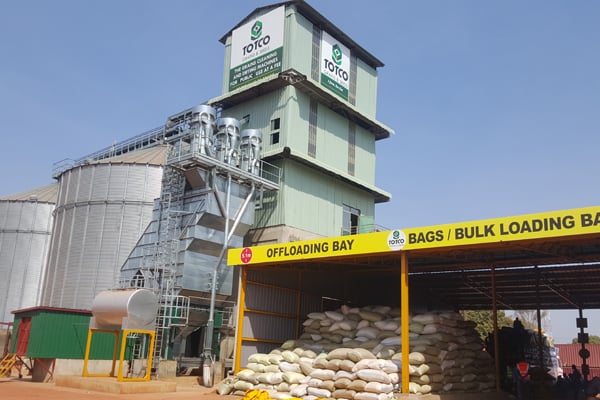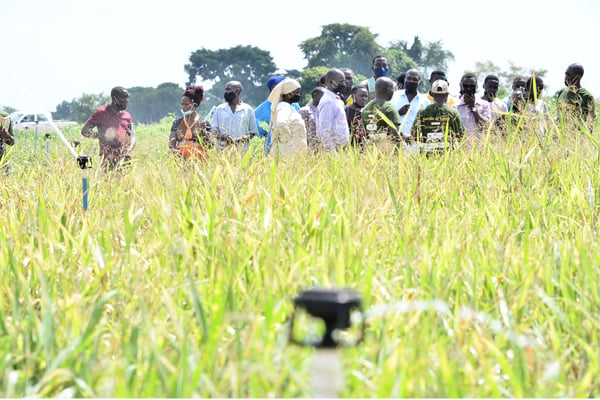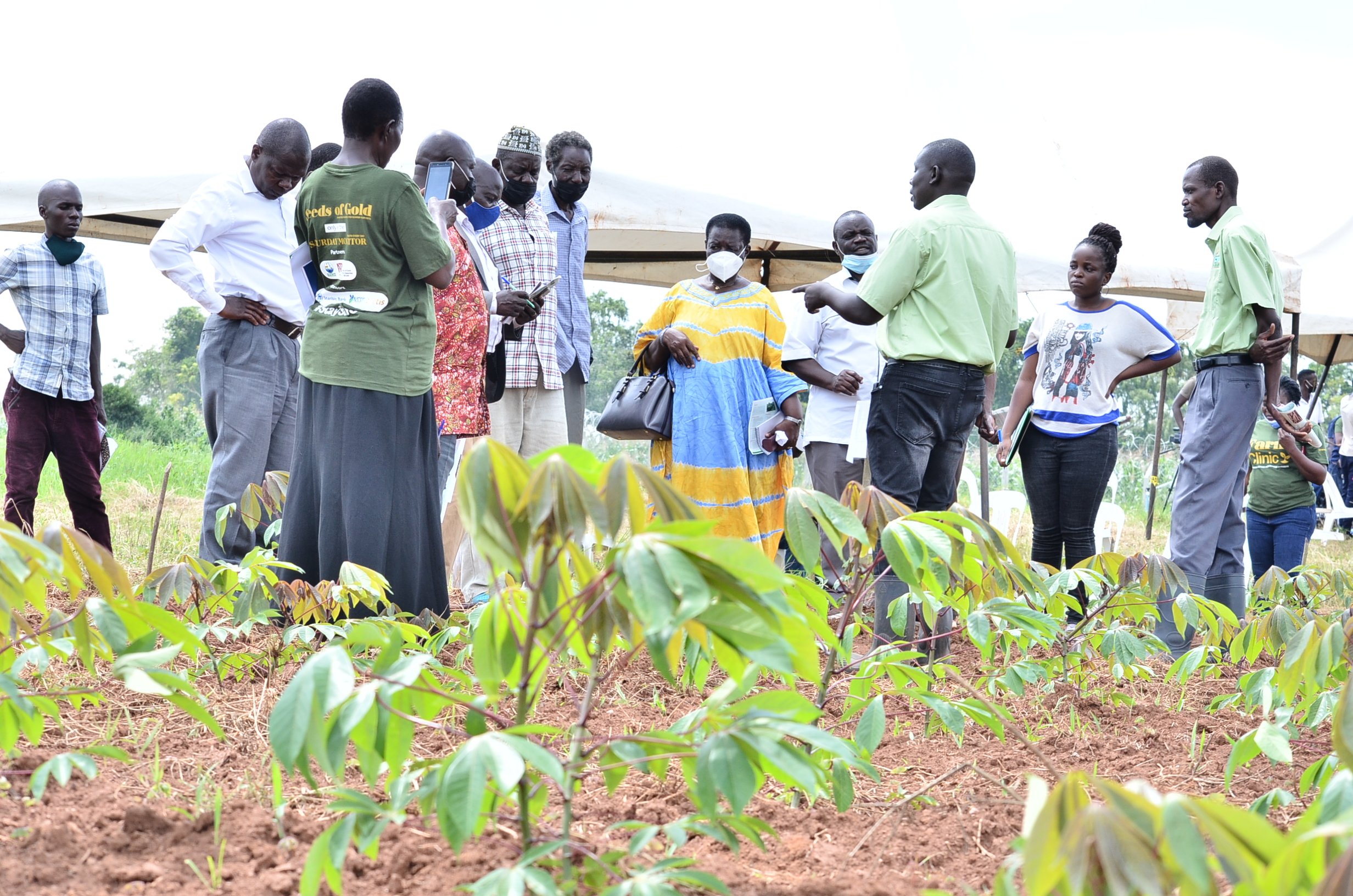Prime
Grain storage facility improves harvest efficiency in Lango

The Totco grain drying and storage facility in Lira. This facility is helping more than 15,000 smallholder farmers improve their harvest. Photos / George Katongole.
What you need to know:
- Storing crops is no less important than growing - crop storage losses do great damage to the economy, reducing food and material resources. In Uganda, farmers lose up to a third of their grain after harvest, because of storage.
- This is due to improper storage conditions, contamination, mold and pest activity. This results in the loss of thousands of tonnes of grain that never reach the consumer, and grain growers suffer considerable losses as a result. With a grain storage facility in Lira, farmers are able to deal with harvest bottlenecks, solving storage and drying issues thus providing improved efficiency and grain marketing flexibility.
Smallholder farmers in Uganda lose between 26 and 37 per cent of the total grain after harvest, because they often use poor grain storage technologies and ineffective drying practices. Staples such as maize stored on-farm are exposed to infestation by insects and fungi. These can lead to contamination with mycotoxins — in particular, aflatoxins, poisonous food toxins produced by fungi.
At high doses, aflatoxins can kill, while at chronic exposure, they impact human health, suppressing immune systems, hindering child growth and even causing liver cancer. They are also highly toxic to livestock and poultry.
Uganda is a particular hotspot for aflatoxins, as regular studies show widespread contamination along the food chain, from maize grain to milk and meat.
The Ministry of Trade, Industry and Cooperatives estimates that about 75 per cent of the grains in Uganda are contaminated by aflatoxins with an average concentration level of 21 microgrammes per kilo. It is expected to be much higher in groundnut.
Production of grain is mainly done by small-holder farmers who often store grain in their own warehouses. However, most of these storage facilities are unsuitable for longer grain storage. They are not equipped with grain ventilation, cooling, ozonation systems, environmental conditions fluctuate due to the lack of sealing, which creates favourable conditions for the emergence and spread of microorganisms and pests. Poor storage also leads to decline in nutritional value of grains.
Damaged grains are unsuitable for the food industry, feed, even alcohol production, so if problems are not identified in time, huge financial losses are incurred.
Keeping toxins at bay
There is critical need to develop cost-effective methods of pre and post-harvest handling systems, as well as standardised storage facilities to reduce grains infestation by aflatoxins to an acceptable levels. Key players in the grain sub-sector have constructed some storage and processing facilities, which account for just 12 per cent of total output.
Currently, the national standardised storage facilities for maize can only cater for 550,000 metric tonnes out of 3.2 million MT of total production. Due to the inadequate capacity of storage facilities and poor post-harvest handling practices, Uganda has experienced losses from large customers such as the World Food Programme (WFP). Most grain is now traded as second grade across the borders. But recent trade rows Rwanda and Kenya have left traders with a bitter taste.
Market volatility is widely regarded as being here to stay, but when it comes to aflatoxin management, good storage has a central role in helping to make businesses more efficient.
In the northern Uganda, Lira City at Odokomit Industrial Area, farmers have got a reprieve from Totco Grains and Seeds Company, who have acquired a post-harvest handling facility under funding from the Uganda Development Bank.
George Ogwang, the managing director of Totco, explains that the need began long before 2014 when the facility was formalised.
“We started as small grain buyers in Lira and Oyam districts but we realised most of the grains were contaminated and did not attract good market in the exports to Kenya, Burundi, Tanzania and South Sudan. It became important for our business to establish a facility that would clean the grains and ensure proper storage,” Ogwang says.
Totco majors in cleaning, drying and storing grains such as maize, sorghum, soybean, sunflower and barley. The company buys grains from eight districts of Lango and five districts of Acholi including Lira, Kole, Apac, Amolatar, Lamwo, Kitgum, Nwoya, Omoro and Gulu.
Farmers have always been encouraged by extension workers to embrace the use of hermetic bags as an alternative, but the triple layer bags cost around Shs6,000 to Shs8,000.
Ogwang and his team measured maize grain quality parameters such as grain damage, weight loss in storage, fungal growth and mycotoxins, food quality and seed germination. This is when they came up with interventions of improving storage of grains and cereals.
The Uganda Development Bank’s (UDB) effort to support the economy recover from the shocks of the Covid-19 pandemic got involved with the agribusiness entity offering an eight-year loan to set up a modern facility.
The grain handling facility benefits an estimated 15,000 contract farmers with an average of 3-5 acres. It has a state-of-the-art storage tank with a capacity of 10,000MT up from the previous warehouse that could store up to 4,000MT.
Previously, Totco used to send grains to Agroways Ltd for value addition as it lacked the capacity to do so. With financing from UDB, Totco can now add value to these products and then export them and also sell them locally.
Totco Grains now buys grain at Shs1,000 per kilo at gate price from Shs600 offered by most middlemen.
UDB funding
UDB Managing Director, Patricia Ojangole, notes, that at the onset of the pandemic, the government implemented a raft of measures to support the resilience and a faster recovery of the country’s economy in primary agriculture, agro-industry and manufacturing. As part of these measures, the government committed to capitalise UDB with Shs1t, out of which Shs455b was extended to the bank as part of additional funding.
Between August 2020 to December 2021, UDB disbursed Shs589b to support businesses during the Covid-19 pandemic period with manufacturing, primary agriculture and agro-industry receiving Shs459b, which accounts for 78 per cent of all disbursements.
She says that Totco is a true manifestation of economic development as they are involved in all activities along the value chain including production through the out-grower scheme, procurement, processing of grain, warehousing, distribution and marketing.
“The support your company provides to farmers with regards to technical backstopping through its agriculture team, inputs like seed for production, ready market for farmers output and mechanisation solutions to the farmers including tractor hire services have provided a strong foundation for empowering the community in Lango sub-region,” she says.
Ojangole and her team toured the grain facility last week to assess its progress.
UDB finances projects with a focus on increasing production and productivity of agriculture at farm level for both small-holder and large-scale farmers. The funding is intended to enable farmers access needed inputs such as seeds and fertilisers. The Bank also supports acquisition of appropriate technologies that aid production, post-harvest handling, processing and storage facilities.
Agro-industrialisation is a key pillar as it enables to increase the value of agricultural produce and enhance Uganda’s competitiveness, boost foreign exchange earnings, reduce post-harvest wastage, enhance food security as well as improve livelihoods.
UDB, which is a cheaper source of funding at an annual interest rate of 12 per cent, has supported various other projects in Lango sub-region including farmers projects like Angeta Co-operative Society in Alebtong, Alito United Farmers’ Cooperative Society in Kole District, Acwec Omio in Oyam District and Hope Development Initiative in Amolatar, among others. The bank has also made varied investments in the agriculture value chain including cotton ginning, juice processing, apiary (bee farming and honey processing).
UDB financing is affordable. A minimum of Shs100m can be loaned with the maximum dependent upon the bank’s limit. Loans are subject to a grace period of three years payable up to 15 years.
Looking forward
Most farmers and grain traders have reported an increase in price for clean grain suggesting the potential to increase sales.
Ronald Akol, a machine operator and farmer, reveals that the project offers cheap and reliable services such as produce weighing, grain cleaning drying, grading, sorting and laboratory at a subsidised fee. Indeed, this attracts other traders to the facility to enable them sell clean grains.
“The capacity of the machine, whose operations are automated, can handle more than 50 tonnes every hour. There are no challenges of those that bring their produce for cleaning,” Akol says.
Training farmers is crucial. Proper grain drying is important, but farmers need to take time to check moisture levels and they should not leave their produce on bare ground.
Ogwang suggests that farmers need to improve operations immediately after harvesting to limit contamination.
Totco offers market-driven skills to farmers such as entrepreneurship, bulking, marketing, business planning, budgeting, saving and spending, early land preparation, timely planting, land contouring, mulching, tractor operation, garden maintenance and community engagement.
Ogwang explains that an awareness campaign is necessary to sensitise farmers and consumers about mycotoxin health risks and the benefits of using these effective facilities to prevent contamination.
He adds that mycotoxin mitigation is a year-round process that starts with pre-harvest prevention, and includes strategies for harvest, feed mill operations and transportation, as well as storage.
Further research is needed to identify what incentives work, like subsidising these post-harvest technologies or contract farming for quality maize with a premium price.
The growth focus, at the moment, is in the area of high production for grains.
Challenge
In Uganda, post-harvest losses range between 26-37 per cent of the total harvests (UBOS 2013), mainly due to poor handling methods (at harvesting, inadequate drying cleaning, and grading methods), inappropriate storage methods, and the low storage capacity on farm and at distribution levels in the country. There are very few standardised warehouses for both grain and processed products; and their management is also inefficient to some extent. For the maize grains, Uganda has standardised storage facilities for only 550,000 metric tonnes out of 3.2 million MT of total production.




